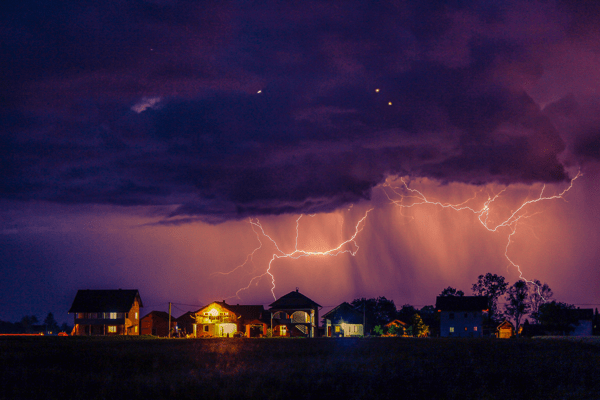
Heavy thunderstorms can wreak havoc on a home. The following tips can help protect your property if you live in an area where storms frequently occur.
Trim or Remove Trees
Storms can snap off tree branches, which can damage your home or detached structures. Get your trees trimmed before the stormy season and cut down any trees that are unwanted. Unless you are confident you can perform this job safely, call a professional tree-trimmer to examine your trees and remove any branches that could snap off during a storm.
Bring In Patio Furniture and Outdoor Items
If a storm is headed your way, make sure all gardening tools, barbeque grills, sports equipment, and lawn furniture are cleaned up and brought indoors. A heavy windstorm could pick up outdoor items and send them flying, damaging your home or windows.
Install Storm Shutters
Heavy rains and turbulent winds can blow out windows. Impact-resistant storm shutters can provide an additional level of security and help protect fragile glass. Storm shutters can also help protect you and your family from hail, flying glass, or other debris while you are within your home.
Install a Surge Protection System
Electrical lines are vulnerable during a thunderstorm. Lightning strikes can cause power outages and falling branches can snap power lines. In heavy storm areas, it is recommended that you put your entire house on a surge protection system. It is also a good idea to unplug electronic equipment and appliances if not in use. If you live in an area with extreme weather patterns, you may want to consider purchasing a home generator to provide power in case of long-term electric outages.
Inspect Your Roof
Get routine roof maintenance. Check the shingles on your roof periodically to ensure they are in good condition. Replace any damaged shingles and use tar or sealants around vents, roof seams, and flashing for chimneys. Cracks in the roof are a leading cause of flood damage. Hail damage to your home’s roof can also be a major concern. Although no roofing material is completely hail-proof, consult with a roofing professional and use hail-resistant shingles.
Install Lightning Rods and Smoke Detectors
To help prevent lighting from starting a fire in your home, install lighting rods that are well-grounded along the peaks of the roof. Lighting rods help direct lightning into the ground instead of the frame of the house. In case lightning does start a fire, put smoke detectors in the attic. Replace the batteries and ensure they are working at least once a year.
Have an Emergency Kit at Hand
Have an emergency kit prepared in advance so that you are ready should a severe storm hit your area. This kit should contain:
- Flashlights
- Battery-powered weather radio
- Extra batteries
- Non-perishable foods
- Bottled water
- Can opener
- First aid kit
- Fire extinguisher
- Blankets
- Extra clothing
- Clock or watch
- Important personal items (such as prescription medications and eyeglasses)
Make Sure You Have The Homeowners Coverage You Need
It is important to know you have proper homeowners insurance coverage in case a severe thunderstorm causes damage to your home. The cost of a homeowners policy is affected by a number of factors, including where you live, the type of construction, the age of your home, and the amount of coverage you choose to put in place beyond the standard requirements. Our experienced agency can review your policy with you to help ensure you have the coverage you need at the best available rates.
Filed Under: Personal Insurance | Tagged With: Homeowners Insurance